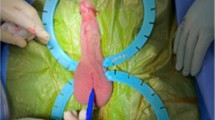Abstract
Straightening maneuvers (SM), including manual penile modeling, tunical relaxing incisions and corporal reconstruction using grafting techniques, are occasionally required during inflatable penile prosthesis (IPP) implantation to ensure functional penile straightness. The aim of this study was to compare the outcomes of men undergoing SM employed during IPP implantation compared with those wherein these maneuvers were not required. A retrospective review of 391 patients undergoing IPP implantation at the Johns Hopkins Hospital from January 2000 to December 2011 was performed. Patients in whom some SM was employed (SM, n=93, 23.9% of the overall cohort) were compared with those for whom SM was not required (IPP group, n=298). Seven patients were excluded from final analysis (6 patients with IPPs inserted in neophalli (SM group), and 1 patient with incomplete data (IPP group). Patients in whom a SM was used were younger (55.4 vs 62.3 years), more likely to have Peyronie’s disease, and less likely to have prostate cancer, radical prostatectomy or to have previously used erectile aids (all P<0.05). Mean operating room time in the SM group was longer (173.8 vs 152.9 min, P=0.003). Within the SM group, modeling was performed in 40 (43%), tunical relaxing incisions in 37 (39.8%) and tunical reconstruction in 16 (17.2%) (most commonly using allograft dermis or pericardium, or synthetic gore-tex grafts). There were no significant differences in terms of device infection (P=0.15), mechanical failure (P=0.23) or erosion (P=0.96). Although limited in size, this cohort study suggests that IPP implantation in men with penile deformity requiring complex reconstruction to achieve straightening may be done proficiently and without increased adverse outcome risk.
This is a preview of subscription content, access via your institution
Access options
Subscribe to this journal
Receive 8 print issues and online access
$259.00 per year
only $32.38 per issue
Buy this article
- Purchase on Springer Link
- Instant access to full article PDF
Prices may be subject to local taxes which are calculated during checkout

Similar content being viewed by others
References
Tal R, Heck M, Teloken P, Siegrist T, Nelson CJ, Mulhall JP . Peyronie’s disease following radical prostatectomy: incidence and predictors. J Sex Med 2010; 7: 1254–1261.
Ralph D, Gonzalez-Cadavid N, Mirone V, Perovic S, Sohn M, Usta M et al. The management of Peyronie’s disease: evidence-based 2010 guidelines. J Sex Med 2010; 7: 2359–2374.
Wilson SK, Delk JR . A new treatment for Peyronie’s disease: modeling the penis over an inflatable penile prosthesis. J Urol 1994; 152: 1121–1123.
DiBlasio CJ, Kurta JM, Botta S, Malcolm JB, Wan JY, Derweesh IH et al. Peyronie’s disease compromises the durability and component-malfunction rates in patients implanted with an inflatable penile prosthesis. BJU Int 2010; 106: 691–694.
Knoll LD . Use of penile prosthetic implants in patients with penile fibrosis. Urol Clin North Am 1995; 22: 857–863.
Martínez-Salamanca JI, Mueller A, Moncada I, Carballido J, Mulhall JP . Penile prosthesis surgery in patients with corporal fibrosis: a state of the art review. J Sex Med 2011; 8: 1880–1889.
Carson CC . Penile prosthesis implantation in the treatment of Peyronie’s disease. Int J Impot Res 1998; 10: 125–128.
Wilson SK, Cleves MA, Delk JR 2nd . Long-term followup of treatment for Peyronie's disease: modeling the penis over an inflatable penile prosthesis. J Urol 2001; 165: 825–829.
Levine LA, Benson J, Hoover C . Inflatable penile prosthesis placement in men with Peyronie's disease and drug-resistant erectile dysfunction: a single-center study. J Sex Med 2010; 7: 3775–3783.
Chung E, Solomon M, Deyoung L, Brock GB . Comparison between AMS 700™ CX and Coloplast™ Titan inflatable penile prosthesis for peyronie's disease treatment and remodeling: clinical outcomes and patient satisfaction. J Sex Med doi:10.1111/jsm.12009(epub ahead of print).
Charlson ME, Pompei P, Ales KL, MacKenzie CR . A new method of classifying prognostic comorbidity in longitudinal studies: development and validation. J Chron Dis 1987; 40: 373–383.
Wolters U, Wolf T, Stützer H, Schröder T . ASA classification and perioperative variables as predictors of postoperative outcome. Br J Anaesth 1996; 77: 217–222.
Mulhall J, Ahmed A, Anderson M . Penile prosthetic surgery for Peyronie’s disease: defining the need for intraoperative adjuvant maneuvers. J Sex Med 2004; 1: 318–321.
Levine LA, Dimitriou RJ . A surgical algorithm for penile prosthesis placement in men with erectile failure and Peyronie’s disease. Int J Impot Res 2000; 12: 147–151.
Chaudhary M, Sheikh N, Asterling S, Ahmad I, Greene D . Peyronie’s disease with erectile dysfunction: penile modeling over inflatable penile prostheses. Urology 2005; 65: 760–764.
Garaffa G, Minervini A, Christopher NA, Minhas S, Ralph DJ . The management of residual curvature after penile prosthesis implantation in men with Peyronie’s disease. BJU Int 2011; 108: 1152–1156.
Gholami SS, Gonzalez-Cadavid NF, Lin C-S, Rajfer J, Lue TF . Peyronie’s disease: a review. J Urol 2003; 169: 1234–1241.
Segal RL, Burnett AL . Surgical management for peyronie's disease. World J Mens Health 2013; 31: 1–11.
Rahman NU, Carrion RE, Bochinski D, Lue TF . Combined penile plication surgery and insertion of penile prosthesis for severe penile curvature and erectile dysfunction. J Urol 2004; 171: 2346–2349.
Author information
Authors and Affiliations
Corresponding author
Ethics declarations
Competing interests
The authors declare no conflict of interest.
Rights and permissions
About this article
Cite this article
Segal, R., Cabrini, M., Bivalacqua, T. et al. Penile straightening maneuvers employed during penile prosthesis surgery: technical options and outcomes. Int J Impot Res 26, 182–185 (2014). https://doi.org/10.1038/ijir.2014.7
Received:
Revised:
Accepted:
Published:
Issue Date:
DOI: https://doi.org/10.1038/ijir.2014.7
Keywords
This article is cited by
-
Advances in the Surgical Treatment of Peyronie’s Disease
Current Sexual Health Reports (2016)


